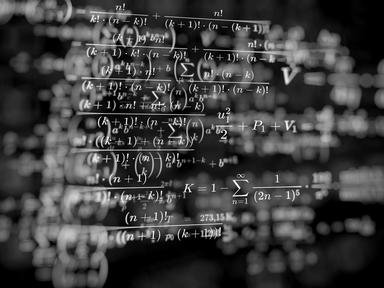Quiz Answer Key and Fun Facts
1. Arithmetic:
Which of the following is equal to (-5)*(-3)*(-2) ? [Here * denotes multiplication.]
2. Algebra:
Evaluate -x^2 when x = 3. [Be careful here! Note that ^ represents exponentiation.]
3. Geometry:
What is true about the two acute angles of a right triangle (in the Euclidean plane?)
4. Trigonometry:
For a certain angle, the cosine is negative and the sine is positive. Which quadrant contains this angle?
5. Analytic Geometry:
What do we call the set of all points in the plane for which the sum of the distances from two distinct fixed points is a constant?
6. Calculus:
Suppose f is differentiable for all real numbers x and let g(x) = x*f(x). Which of the following is equal to the derivative of g(x)?
7. Analytic Geometry with Vectors:
Which of the following is the equation of a line through the origin with normal vector 2i - j?
8. Elementary Number Theory:
How many positive integers less than or equal to 15 are relatively prime to 15? [Relatively prime means they have no common factors other than 1.]
9. Basic Set Theory:
Let A and B be subsets of a universal set U with A a subset of B. Let A' denote the complement of A and B' denote the complement of B. How are the complements related?
10. Linear Algebra:
Let S denote the subspace of R^3 which consists of all ordered triples of real numbers (x,y,z) which satisfy x + y + z = 0. Which of the following is a well-defined linear transformation T taking S into itself?
11. Group Theory:
What is the smallest order of a nonabelian simple group?
12. Ring Theory:
Let Z denote the ring of integers and let (10, 15) denote the ideal of Z generated by 10 and 15. Which of the following ideals is also equal to (10, 15)?
13. Real Analysis:
Let f(x) be defined for all real numbers x by:
f(x) = x * sin(1/x) for x not equal to 0 and f(0) = 0
Which of the following is TRUE?
14. Complex Analysis:
What is the modulus (absolute value) of the complex number 4 + 3i?
15. Basic Topology:
Let R denote the set of real numbers with the usual topology and let X denote the closed interval [0,2] with the subspace topology. Let S denote the interval (1,2]. Which of the following is true about S?
Source: Author
rodney_indy
This quiz was reviewed by FunTrivia editor
crisw before going online.
Any errors found in FunTrivia content are routinely corrected through our feedback system.

